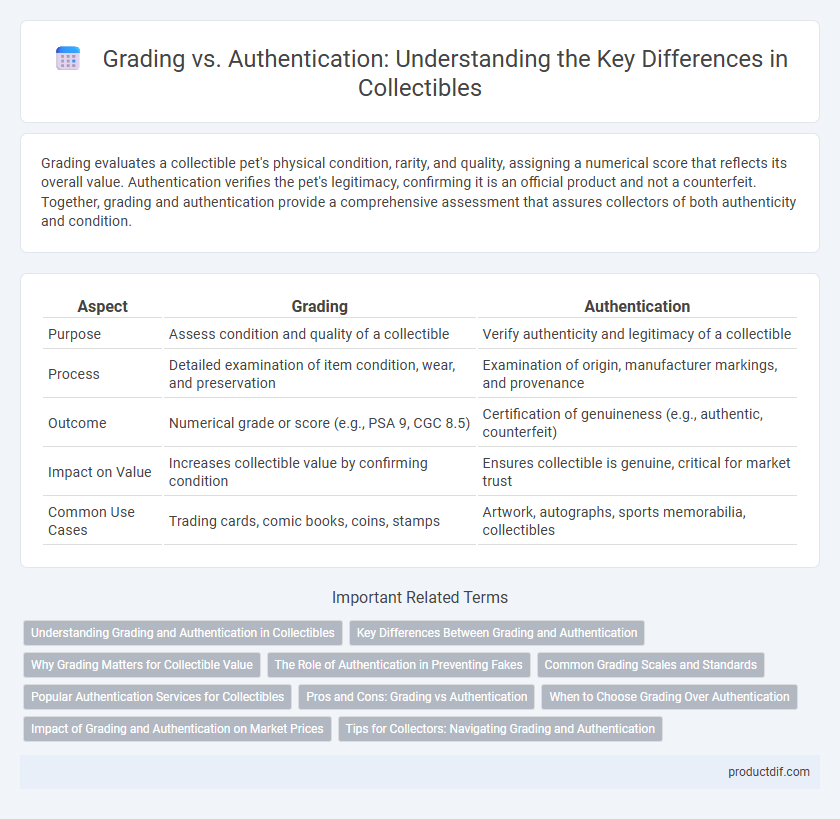Grading evaluates a collectible pet's physical condition, rarity, and quality, assigning a numerical score that reflects its overall value. Authentication verifies the pet's legitimacy, confirming it is an official product and not a counterfeit. Together, grading and authentication provide a comprehensive assessment that assures collectors of both authenticity and condition.
Table of Comparison
| Aspect | Grading | Authentication |
|---|---|---|
| Purpose | Assess condition and quality of a collectible | Verify authenticity and legitimacy of a collectible |
| Process | Detailed examination of item condition, wear, and preservation | Examination of origin, manufacturer markings, and provenance |
| Outcome | Numerical grade or score (e.g., PSA 9, CGC 8.5) | Certification of genuineness (e.g., authentic, counterfeit) |
| Impact on Value | Increases collectible value by confirming condition | Ensures collectible is genuine, critical for market trust |
| Common Use Cases | Trading cards, comic books, coins, stamps | Artwork, autographs, sports memorabilia, collectibles |
Understanding Grading and Authentication in Collectibles
Grading in collectibles assesses the condition and quality of an item, assigning a numerical or descriptive value that impacts its market value and desirability. Authentication verifies the item's genuineness, ensuring it is not counterfeit or altered, which is crucial for trust and provenance. Understanding both grading and authentication is essential for collectors to make informed decisions and protect their investments.
Key Differences Between Grading and Authentication
Grading evaluates the condition and quality of a collectible, assigning a numerical or letter grade based on factors like wear, preservation, and rarity, which directly affects its market value. Authentication confirms the item's legitimacy by verifying its origin, genuineness, and creator, ensuring it is not counterfeit or altered. While grading impacts the collectible's value and marketability, authentication provides trust and verifies authenticity without assessing condition or grade.
Why Grading Matters for Collectible Value
Grading establishes the condition and quality of collectibles through standardized criteria, directly impacting market value and buyer confidence. High-grade collectibles consistently achieve premium prices due to verified preservation and rarity. Authentication alone confirms legitimacy, but grading quantifies condition, making it essential for accurate valuation and investment decisions.
The Role of Authentication in Preventing Fakes
Authentication plays a crucial role in preventing fakes by verifying the originality and provenance of collectibles through expert analysis and advanced technology such as digital certificates and UV light inspection. It enhances buyer confidence by ensuring that items are genuine before they reach the market, reducing the circulation of counterfeit products. Authentication often serves as the first line of defense in collectible trading, complementing grading processes that assess condition but do not necessarily confirm authenticity.
Common Grading Scales and Standards
Common grading scales for collectibles, such as the 1 to 10 numerical scale or the Sheldon scale for coins, provide standardized measures of condition that impact value and marketability. Authentication verifies the item's genuineness, while grading assesses its condition based on criteria like wear, color, and defects, with organizations like PSA for trading cards and NGC for coins leading the industry. Understanding these standards ensures collectors make informed decisions about investment quality and authenticity.
Popular Authentication Services for Collectibles
Popular authentication services for collectibles, such as PSA (Professional Sports Authenticator), Beckett Authentication Services (BAS), and James Spence Authentication (JSA), play a critical role in verifying the legitimacy of trading cards, autographs, and memorabilia. These companies use expert analysis, proprietary databases, and advanced forensic techniques to confirm authenticity, protecting collectors from counterfeit items. Authentication enhances collectible value by ensuring buyer confidence and market trust in rare or high-demand assets.
Pros and Cons: Grading vs Authentication
Grading offers a standardized numerical or letter scale that assesses the condition and quality of collectibles, enhancing marketability and providing a clear value indicator, but it can be costly and sometimes subjective based on grader expertise. Authentication confirms the legitimacy and origin of an item, reducing the risk of counterfeits and ensuring buyer confidence; however, it does not evaluate condition, which may affect desirability and price. Combining grading and authentication offers comprehensive assurance but increases overall expenses and processing time for collectors.
When to Choose Grading Over Authentication
Choose grading over authentication when the collectible's condition significantly impacts its market value or resale potential, such as coins, trading cards, or comic books. Grading provides a standardized, numerical assessment of condition, appealing to collectors and investors who prioritize quality and preservation. Authentication alone confirms genuineness but doesn't communicate the collectible's state, making grading crucial for high-value or condition-sensitive items.
Impact of Grading and Authentication on Market Prices
Grading and authentication significantly influence collectible market prices by providing verified quality and legitimacy, which boosts buyer confidence and drives demand. High-grade collectibles typically command premium prices, as grading certifies condition and authenticity, minimizing risk for investors. Authentication prevents counterfeit circulation, preserving market integrity and directly increasing the value of genuine items.
Tips for Collectors: Navigating Grading and Authentication
Collectors should prioritize obtaining both grading and authentication services to maximize the value and credibility of their collectibles. Understanding the differences between grading companies and authentication experts helps in selecting the right service for coins, cards, or memorabilia. Regularly verifying certification details through official databases ensures the legitimacy and condition of the items remain trustworthy.
Grading vs Authentication Infographic

 productdif.com
productdif.com